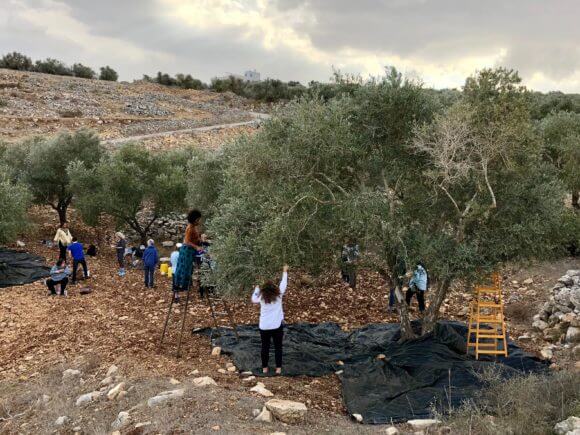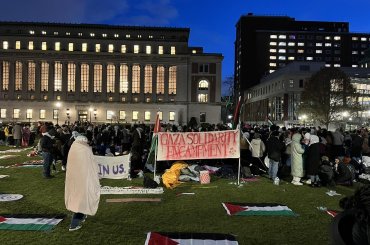
Every year since 1993, the UN has marked March 22 as World Water Day. This date gives us the opportunity to raise the profile of water both as a fundamental need to sustain life, and as a human right – which the UN General Assembly declared it was in July 2010.
This year’s World Water Day theme – “leave no one behind” – has an acutely jarring ring when applied to Israel.
Since 1967 when Israel issued several military orders asserting its control over all water sources in the newly occupied territories (Palestinians were denied the right to drill wells or repair existing ones and the orders decreed that any Palestinian water installation built without a permit would be destroyed), its policies have been aimed at depriving Palestinians access to the water they once enjoyed, and punishing them for further use.
The result is that Palestinian agriculture which, according to World Bank figures, accounted for 13 percent of the Palestinian GDP in 1994, accounts for only three percent today.

That precipitous slide was initiated by Oslo II (1995), which gave Israel sole control over so-called Area C, the 61 percent of West Bank land most suitable for agricultural production, and allocated to Palestinians 138.5 million cubic meters (mcm) of water a year, which was 20 percent of the West Bank water supply. Israel and its settlements grabbed the rest.
Since 1995, the Palestinian population has doubled and that 138.5 mcm allocation has shrunk.
A 2013 World Bank report stated that Palestinians only had access to 87 mcm of water, that Palestinian water access per capita had declined by more than 30 percent, that half of the Palestinian wells had dried up over the last 20 years, and that farmers were unable to irrigate their land.
Other studies have found that by 2016, only 6.8 percent of cultivated West Bank land was irrigated, and 600,000 settlers were using six times more water than the entire Palestinian population of the West Bank, 2.8 million people.
The latest Report of the Special Rapporteur on the situation of human rights in the Palestinian territories published on March 15, 2019 is scathing about Israel’s water policies:
“Water, and its effective control and management, is an essential component for the exercise of sovereignty in the modern world. Yet, as Israel’s 51-year-old occupation has become more entrenched, the deeply inequitable distribution of water imposed by Israel illustrates the utter lack of any substantive control Palestinians over their daily lives. With the collapse of the natural sources of drinking water in Gaza and the inability of Palestinians to access most of their water sources in the West Bank, water has become a potent symbol of the systematic violations of human rights occurring in the Occupied Palestinian Territory. While Israelis, including those living in illegal settlements, enjoy unlimited running water year-round, several million Palestinians endure water shortages caused either by contamination or by lack of access. The irony is manifest: while Israel has created world-class hydro technology for the creation and export of desalination plants, advanced irrigation systems and the recovery and productive recycling of wastewater, the Palestinian territory it occupies is water insecure. Indeed, the World Bank stated in 2009 that the Palestinians in the occupied territory have the lowest access to fresh water resources in the region, notwithstanding the fact that the Palestinian territory has ample water resources.”
The Report concludes that Israel’s “expropriation of Palestinian hydro resources breaches both international humanitarian and human rights law, and scorns the principles that underlie the right to water.”
What does this water deficit look like on the ground? Last November I had the opportunity to see how farming was faring when I co-led an Eyewitness Palestine environmental justice delegation to the West Bank.
We were told about the “agricultural terrorism” practiced by settlers and soldiers, who over the last few decades have uprooted 2.5 million fruit trees and 800,000 olive trees and poisoned Palestinian farms with raw sewage.
We heard that thousands of Palestinian farmers have lost their livelihoods to the separation wall that cuts deeply into the West Bank, enabling Israel to appropriate both land and Palestinian water resources, and to bypass roads that separate farmers from their fields.
Now about 70 percent of the 61 percent of the West Bank known as Area C is reserved for 200 settlements and outposts, military firing zones, and nature reserves off limits to Palestinians, while approximately 300,000 Palestinians live in 540 communities, at least 180 of which have no connection to a water network.
The unrelenting destruction of Palestinian wells, cisterns, reservoirs and pipes connecting villages to a water supply, and the ongoing appropriation of Palestinian springs and other water sources for Israeli use only have intensified the impact of Israel’s apartheid water policies.
The goal? To force Palestinians to leave and clear the land for settlement expansion.
We visited a farm in Asira ash-Shamaliya, near Nablus, to help the Yasin family pick their olives. It was in beautiful hilly location without an Israeli settlement on the horizon.
But we learned that even here, with olive trees spread amply over the hills, it was not easy to make a living off the land. Many family members had to hold additional jobs in order to get by.
One of them was Hamad Yasin, who farms and works as a civil engineer. He told us that each olive tree needs 11 cubic meters of water per year to get good production. But it was illegal to have ground wells deeper than 150 meters, and to get water, he said, they would have to go down 450 meters.
“Now we depend entirely on rainwater and we don’t have enough rain. And sometimes Israel says you are not allowed to collect rainwater. What can we do?”
The picture is particularly stark in the Jordan Valley, once the West Bank’s bread basket. Now it is home to 12 major Israeli wells and its aquifer is being rapidly reduced by the pumping stations maintained by Israel’s National Water Carrier, Mekorot. They supply Israeli settlement greenhouses and farms, which may soon be unsustainable, given the speed at which the water table is declining.
Most of the Palestinian communities in the Jordan Valley have been declared part of Area C, where building of any kind is forbidden, where many existing structures have demolition orders, and where Palestinian herders and farmers are not permitted to collect rainwater. More than 90 percent of the Jordan Valley has been set aside for settlements and military zones that Palestinians are forbidden to enter.
We visited the site of what had once been a major Palestinian water source, the Al-Auja spring. So voluminous was its water, we were told, that people would come from elsewhere in the West Bank to gaze on the waterfalls flowing over the arid landscape. Visitors would swim, fish and have picnics on the banks of its stream, which supplied plentiful water to Palestinian farms and villages in the area.
In 1972 Israel sank two deep water wells at the site and now the spring appears totally dry. Nearby Israeli settlements and greenhouses are served by a Mekorot pumping station that pumps 2,000 cubic meters of water per hour from a depth of over 1,000 meters.
Palestinians in the Jordan Valley, including in the city of Jericho, are forced to buy their water back from Mekorot at a rate six times higher than the amount Israelis pay, while Jordan Valley settlers use eight times more water per capita than their Palestinian neighbors.
Mekorot pumping stations may look fairly insignificant, but they are in fact an engine of Palestinian dispossession and environmental devastation. In the Jordan Valley they have increased the desertification of the land, killed once-flourishing agriculture on Palestinian farms and made it all but impossible for the Bedouin in the region to keep their flocks fed and watered.
It was reported on February 22, 2019 that Palestinian shepherds who attempted to graze their sheep in the Al-Auja area were driven out of the area by soldiers, as Israel hastens the ethnic cleansing of the Jordan Valley.
Our journey through occupied rural Palestine was not entirely bleak, for we also encountered instances where the resistance of Palestinian farmers remains vigorous and creative.
From the Tent of Nations near Bethlehem, where the Nasser family is determined not to be driven out by the settlements that ring their farm, to the innovative cooperative Om Sleiman farm in Bil’in, bordered by the giant Modi’in settlement complex, Palestinian farmers are digging in for the long haul. This World Water Day we should honor their steadfastness (sumud in Arabic) as we demand water justice for the Palestinian people.


